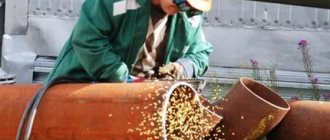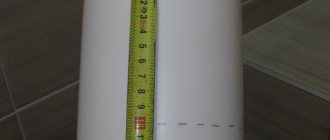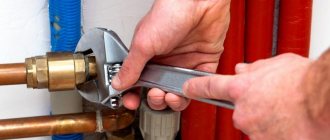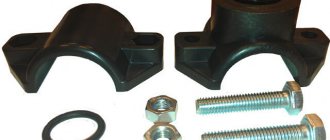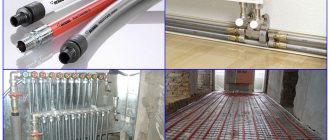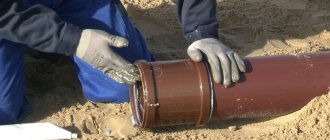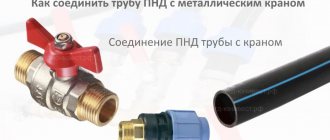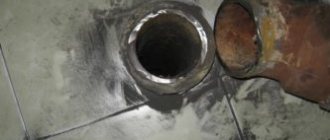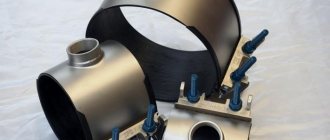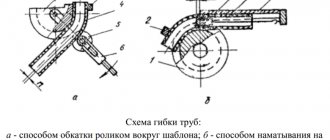We measure
The first method is not entirely convenient, but quite accurate. Suitable if you are “in the tundra” and have nothing at hand except a pencil and tape measure. I had to use it a couple of times. The diameter of the pipes does not matter.
An important condition is the presence of a flat plane near the cut. This could be the edge of a pipe, a socket, a put-on or welded-on coupling, a seam, or any other concentric circle.
We mark the place of the cut with a risk. We measure the distance from the mark to a flat plane. We rearrange the tape measure along it and make risks in a circle, using the given size. We get a circle from the marks.
We crimp
A method widely replicated on the Internet. Take a sheet of paper or newspaper. We wrap the pipe so that the edges meet at one point. The edge of the newspaper is the cutting plane. We draw with a pencil or marker - the marking is ready.
I don’t see any restrictions on pipe diameter here. The only question is what to take for wrapping. Rolled paper (for example, fax) is suitable for marking new large-diameter pipes. For old rusty pipes, we made clamps from steel tape about fifteen centimeters wide.
The materials can be different: masking tape, roll of sandpaper, roll of penofol, etc. The denser and wider the tape, the more accurate the markings.
General characteristics of polypropylene pipes
It is worth mentioning that polypropylene is synthetic and has many positive qualities. This is light weight, high elasticity, heat resistance and zero susceptibility to corrosion, which is extremely important for plumbing. This is a type of plastic, but with a low density, which makes it so lightweight.
Soldering polypropylene pipes is simple, having a minimum of tools, which we will talk about later, as well as fittings (special small parts of different shapes made of polypropylene) that act as connectors.
If we talk about the main advantages of polypropylene in more detail, the following points stand out clearly:
- Durability - the service life of such a cavity, if cool water is supplied through it, is 50-60 years, in the case of hot water - 30-40 years.
These characteristics are even higher than those of various analogues.
Heat resistance
In addition to the general features of water pressure pipes made of polypropylene, it is worth knowing one more factor - heat resistance.
The fact is that polypropylene is a type of plastic and there is a temperature limit inside the system at which the area is damaged or melts.
The maximum operating temperature of PP pipes is 140 degrees Celsius. This means that if the water is very hot, there is a risk of breaking the integrity and even the soldering of polypropylene pipes (the joint) may not withstand.
But when developing the pipes under discussion, they are assigned their own marking, which indicates certain properties, such as: heat resistance, wall thickness, permissible pressure in the system and areas of implementation. Thus, two common markers are distinguished:
- PN 20 is the most popular type of pipe, withstands a pressure of 20 atmospheres and a temperature of 95 degrees Celsius.
These characteristics allow use in laying water pipes for the use of hot and cool water, but not in heating systems.
Thermal elongation
Another property of polypropylene pipes is their ability to elongate as the temperature inside the water supply increases.
It looks like sagging of long sections of the water supply system, or wave-like deformation. For this reason, it is necessary to correctly solder polypropylene pipes and it is not recommended to make long straight pipes in the water supply system, but to use compensators (pipe insertion in the form of the letter “P”). Then, during thermal elongation, the “legs” of the compensator will come closer together, and the pipe will not deform.
Soldering polypropylene pipes in hot systems also involves the use of reinforced ones, this will reduce the risk of thermal elongation and deformation.
Reinforcement
And the extreme in the properties of polypropylene cavities, which is worth mentioning, is reinforced, because they have already been discussed in the text.
It is important to reinforce pipes, because this involves the inclusion of duralumin foil or nylon fibers in their composition, which increases the strength, hardness, heat resistance and service life of water pipelines made from this material.
Soldering reinforced polypropylene pipes is as simple as simple ones; installation is carried out using the same tool, only the melting temperature when fastening sections of water pipes with fittings is different.
Let's spin
The method I most often use when trimming small diameter pipes.
I place the pipe against the wall, resting its free end against a corner (if necessary, I put something under it to prevent the pipe from rolling away). At the place of the cut, I touch the pipe with a pencil or marker. To keep my hand from shaking, I rest it on the wall. I rotate the pipe by the edge, and the pencil outlines an even cutting line.
It may seem that the method is only suitable for small pipes. Once we managed to mark a pipe just over a meter in diameter.
Once they brought to the workshop a pipe three meters long and something about twenty meters in diameter, I don’t remember exactly. They told me to cut it off. Frankly speaking, this is a non-standard task for us. But we managed.
After a brainstorming session, we drove to a carpenter and brought in a factory-made sheet of plywood. One side was placed tightly under the pipe (at an angle to the future cutting line). A line was drawn along the second side along the floor - this is a perpendicular.
Then everything is as described above, only on a large scale. Two men rolled the pipe, trying to do it as evenly as possible. The third placed a marker on the pipe and guided it along the line marked on the floor. At the end, the marking closed, which means we succeeded. There are no unsolvable problems. You just need to be smart.
That's all for me. Thank you for reading. If the article was useful, subscribe to the channel
and, of course, give it a thumbs up.
Tags: device for longitudinal marking
Comments 58
There is this troll here, terafox, the most crazed creature. He’s stupid, but he’s always clever to everyone, like he does things better.
Centering will be more correct. But in general, the idea is not bad.
“UNREAL” has disappeared somewhere...
Nonsense if you have a marking caliper
I always made do with just a marking caliper... why bother bothering with unnecessary crap when a universal tool was invented long ago, tested for decades on both wood and hardware.
Simple and reliable. 5 plus!
A specialized tool that you can easily do without, but manufacturing for the sake of manufacturing and then putting it on a shelf is nonsense.
worked on the basis of the technical maintenance of the trawl fleet... there the sheets were marked with an ordinary nylon thread... it was rubbed with chalk, then at the extreme points of the sheet they were placed at the ends on marks and pulled back like a string, it hit the sheet, the chalk flew off it and a clearly visible line was obtained...
I’ll do a cool thing too, I decided to use a barbell to measure it. +++ And I liked the riveter too, but there is no lathe.
Make a profile a little more “homemade”? Nonsense
You can do without a lathe... clamp the scriber into the wood with a screw. Or optimize according to your capabilities
The device is useless. A caliper will do the job just as well. In addition, this thing puts a mark strictly in the center and when sawing, you will get identical halves of horseradish - one of the halves will be smaller by the thickness of the cutting tool. Although there may be specialists who know the secret of cutting in the center of the mark, I’m definitely not one of them.
As a matter of principle, I don’t watch videos with titles like: “Unrealistically cool homemade product, make it for yourself right now.” You open it and there you need a lathe. And most often, an unrealistically cool device is shit on a stick, only the shit is turned on a milling machine and the stick is made of an iron rod (turned on a lathe, of course).
Yes! X with him with lathe. I just don’t want to waste time. At least sign what kind of crap it is and why so as not to waste time on “unrealistically cool homemade products”
45 degree cutting
One particular example of such a situation is the need to cut a metal pipe at an angle of 45 degrees. Such cutting of material is often required when laying water pipes or heating systems. In this case, you have to deal with steel pipes. For these purposes, conventional cylindrical pipes are usually used. If we are talking about the installation of some kind of metal structures, then profile pipes of rectangular or square cross-section are more often used. The main problem here is that in order for the elements to be connected to coincide, the cut must be as smooth as possible, which means that especially close attention should be paid to marking the material.
In cases where cutting at an angle is required, a simple square sheet of paper can be used as a marking template. It must be folded strictly diagonally, and then wrapped around the pipe with the template. In this case, it is necessary to carefully ensure that the side of the sheet, which is located closer to the end of the pipe, is perpendicular to its central axis. Next, using marking material, a series of dotted lines is applied and after the marking is completed along the entire circumference, the template can be removed.
If you have to cut a profile pipe, then it is advisable to make a special template from the same pipe, but with a larger cross-section. In this case, you will only have to use the measuring devices once. To apply markings you will need to use a protractor or a construction square. After sawing off the template, the pipes to be cut can simply be inserted into it and marked. This approach will significantly save work time and cutting a profile pipe at 45 degrees will be convenient.
As for what to use when carrying out work, you should choose the most suitable and familiar one. This can be a simple hacksaw for metal, or a grinder with an installed cutting disc.
Required Tools
In order to cut the pipe straight , it is very important to choose the right tool. The quality of work largely depends on it. So, let's look at the most suitable tools for working on a pipe:
- Bracelet with a hole. This equipment is designed specifically for making the cut. It is convenient and allows you to get the job done efficiently;
- Jigsaw. Allows you to make an even and neat cut. In this case, you do not have to purchase special equipment;
- File. And in this case, the cut is smooth and of high quality. However, working with both a file and a jigsaw takes quite a lot of time;
- Bulgarian. The tool allows you to get the job done quickly and relatively easily. However, there are also disadvantages. The cut is not even enough.
You can choose the tool that suits you best, or that you already have in your workshop.
How to cut a profile pipe evenly
You can cut a profile pipe in much the same way, but here it will be easier to use a square. The device is applied to each side in turn, for which the element to be cut will need to be rotated, and markings are applied. Next, the pipe must be secured firmly and work can begin.
Any suitable tool can be used for sawing. If you have to cut a lot of pipes, then it is advisable to make full-fledged templates from scraps. In this case, measuring and marking work will have to be done only once.
Method 3: Trim by eye in one pass
The fastest way is to trim by eye in one pass. At the same time, with experience you can gain sufficient skills so that the quality of the end is quite suitable for further welding work.
The cutting disc of the grinder is applied to the pipe from above as perpendicularly as possible. With a developed eye, this will work out the first time. After cutting the upper side of the profile, you need to move the disk to the near side. The tool must also run perpendicular to the pipe. Having two intersecting cuts, all that remains is to deepen the disk, and it will cut the profile to the end without distortion on the remaining walls.
Hacksaw or back saw.
A hacksaw or back saw is the most common method for cutting PVC pipe because many people already have one of these in their toolbox or garage. A hacksaw or back saw can work fine, but they can take a long time and may require additional work to remove burrs from the edge of cut PVC pipes. A hacksaw or back saw is the ideal tool
, if you need to cut only a single or several pieces of pipe at the same time. Back saws generally come with a miter box and you can use them together to make a straight cut.
Industrial models (using the example of BSM)
There are special machines for industrial use to perform precise miter cutting operations. A good example: devices produced under the BSM brand. The machine manufacturer is the German company Rexinger.
True, the BSM series machines are designed exclusively for working with polypropylene pipes of fairly large diameters. Processing of products such as PP, PVC, PE, PVDF is supported.
Industrial machine for cutting pipe products made of polymers. Designed to work with large diameter products, but has equipment for processing pipes from 50 mm. The machine provides cutting in a wide range of angles
The cutting tool of the machine is a band saw, thanks to which cuts are made at angles from 0 to 67.5º. The accuracy of the process is ensured by a laser cutting recognizer.
Despite the configuration of the device for large-diameter products, you can use a special table, which can also be used to successfully cut pipes of small diameters (50 - 200 mm), which are easier to cut using a pipe cutter. A wide range of BSM devices is produced.
Pipe cutter with ratchets.
A power saw is indispensable for cutting large quantities of PVC pipes. A power saw, however, is an expensive piece of equipment. If you have the only one or you have access to it
, and you can learn how to use it completely safely, you can use an affordable wooden blade to cut PVC pipes without purchasing a special blade. You should definitely read and understand the instructions that come with your miter saws.
As you can see, there are many very simple ways to cut PVC pipe. Therefore, choose the one that suits your liking.
High-quality cutting of polypropylene pipes
Due to the growing popularity and prevalence of pipes made of polypropylene (propylene polymer), used for arranging water supply systems and other communications, the demand for specialized tools that make working with the material has increased significantly.
Special, exceptional attention is paid to the correct choice of scissors model for cutting polypropylene pipe products. This greatly simplifies the preparation of the entire set of parts for wiring installation.
As a rule, straight sections (up to 12.0 m) are sold on the market, although polypropylene pipes in coils are often found, used for installing underfloor heating systems.
Technique for cutting plastic knots
Working with PP pipes is simple, but a number of requirements for cut quality must be strictly observed:
- Scissors for polypropylene pipes must be placed strictly perpendicular to the plane, the cut must be at a right angle.
- Thick-walled, inelastic pipes can crack from one-sided pressure: for prevention, dense templates can be pushed into the cut area so that the knife passes between them.
- After cutting, the nodes are immediately installed or closed with sealed plugs.
This will prevent dust and dirt from getting inside the pipe.
Ratchet Pipe Cutter
Pipe cutter
The power saw is ideal for cutting large quantities of PVC pipes. Power saws, however, are expensive. If you already have one or have access to one and know how to use it safely, you can use an existing wooden blade to cut PVC pipe without purchasing a special blade. Be sure to read and understand the instructions that came with your miter saw.
The nuances of working with a rectangular section
Rectangular workpieces are much easier to cut lengthwise and crosswise at any angles than cylindrical elements, which are difficult to hold stationary on a flat surface. Transverse cutting of workpieces at any angle does not present any particular difficulties - the line of the required angular slope is drawn on the side edge and always coincides with the calculated one (round elements require the use of special patterns, calculated on a computer, to align their edges at an angle other than a straight line).
The thickness of the walls of a metal profile when used in households rarely exceeds 5 mm - it is easy to cut using an angle grinder with any metal disc.
Rice. 2 Types of transverse marking methods
Paper pattern for pipe
Using a paper sheet is a simple method of marking a rectangular or square profile for precise cutting at an angle of 90 or 45 degrees towards its axis.
To make markings for cross cutting at an angle of 90 degrees, take a sheet of paper and wrap it around the pipe until the edges line up exactly, after which they are glued together. With this method, the cutting line is very clearly visible, unlike drawing it with a pencil or marker along the edge of the template.
After this, the profile is cut along the template edge alternately from all sides, trying to avoid complete cutting of the finishing sections - this can lead to the disk hitting sharp corners and its destruction.
A sheet of paper can also be used to mark the side walls of rectangular or square pipes. To do this, the paper sheet is folded diagonally, and the resulting 45-degree angle is applied to the side walls and the appropriate markings are made. To ensure that the side lines are at the same level, an acute angle is applied to the transverse line placed at an angle of 90 degrees to the axis, which is previously applied in the above manner.
Rice. 3 Using a steel template
Miter box for cutting pipes
It is very convenient to cut a profile pipe using a special template, which is an analogue of a construction miter box for cutting building materials at different angles.
To do this, using the above or another method, a metal template is made from a piece of profile pipe cut along the length; it can be designed to obtain a right angle or an angle of 45 degrees.
To cut a metal profile, apply a template to it and draw a line with a scriber, along which a cut is then made. In other cases, the template is held and a grinder is used to draw a line along the surface of the workpiece, trying to avoid strong pressing of the side surface of the disk against the attached metal template. Then the template is removed and cutting continues along a clearly visible depression on the edges of the workpiece.
Using a template, you can get a very straight cut line if you do not hold it manually, but secure it to the workpiece using clamps or mounting bolts. To make your own fasteners, drill a hole in the side surface of the U-shaped plate of the template and weld a union nut at this point from the outside into which the bolt is screwed. To secure the template, place it on the part to be cut and screw in the bolt, pressing the template surface against the workpiece, then use a grinder with a metal disc to make a cut, lightly touching the guide edge.
Rice. 4 How to cut a workpiece with a homemade machine
How to cut a cast iron pipe
If the pipe is made of cast iron, then in order to cut it smoothly you will have to apply certain knowledge. The fact is that this material is characterized by high fragility, which means that before cutting such a pipe, you need to determine an algorithm of actions.
- We mark in the same way as steel pipes.
- At the cutting site, you need to place a wooden beam as a support.
- Next you need to make a cut of a few millimeters around the entire circumference.
- After this, a chisel is inserted into the groove and a sharp and strong blow must be applied with a hammer.
As a result, it will split along the line, forming a fairly even cut area, which can be further processed if necessary.
Another similar option
You can do it differently. First, the same work is done as in the previous version - a strip is drawn, a corner is laid and pressed. But here the groove is made somewhat deeper - 4-5 mm. After the corner is removed, the remaining metal can simply be broken off, and the edge can be processed using an angle grinder with a grinding disc. However, there may be small pits on the edge, which makes the second option more acceptable.
The groove along the guide angle is made a little deeper than in the previous version
How to cut lengthwise
Another frequently asked question is how to evenly cut a pipe lengthwise with a grinder. Here the algorithm of actions will be approximately the same as for transverse cutting. It is important to pay attention to marking. You can, for example, use painting thread, which is usually used when marking walls. In this case, it is necessary to firmly fix the pipe. The sawing process itself must be done carefully and slowly, since when sawing long elements there is a high probability of the cutting disc slipping from the marking line.
Required Tools
In order to cut the pipe straight , it is very important to choose the right tool. The quality of work largely depends on it. So, let's look at the most suitable tools for working on a pipe:
- Bracelet with a hole. This equipment is designed specifically for making the cut. It is convenient and allows you to get the job done efficiently;
- Jigsaw. Allows you to make an even and neat cut. In this case, you do not have to purchase special equipment;
- File. And in this case, the cut is smooth and of high quality. However, working with both a file and a jigsaw takes quite a lot of time;
- Bulgarian. The tool allows you to get the job done quickly and relatively easily. However, there are also disadvantages. The cut is not even enough.
You can choose the tool that suits you best, or that you already have in your workshop.
How to cut metal-plastic pipes
Metal-plastic pipes have a number of advantages over their competitors. They are much lighter than metal and much more resistant to oxidation than copper. They are easy to replace and easy to shape into the desired shape.
You can create a pipeline of any shape. Well, the main advantage is the cost. It is much lower than that of copper pipes. And the quality is approximately at the same level.
During operation, it may be necessary to cut pipes. For this, a special tool is used that is designed to work with such material.
To increase the effectiveness of the procedure, it is recommended to properly prepare the pipe and tools before work. Let's look at the main features of metal-plastic pipes and how to cut them.
Required Tools
In order to cut the pipe straight along, it is very important to choose the right tool. The quality of work largely depends on it. So, let's look at the most suitable tools for working on a pipe:
- Bracelet with a hole. This equipment is designed specifically for making the cut. It is convenient and allows you to get the job done efficiently;
- Jigsaw. Allows you to make an even and neat cut. In this case, you do not have to purchase special equipment;
- File. And in this case, the cut is smooth and of high quality. However, working with both a file and a jigsaw takes quite a lot of time;
- Bulgarian. The tool allows you to get the job done quickly and relatively easily. However, there are also disadvantages. The cut is not even enough.
You can choose the tool that suits you best, or that you already have in your workshop.
Preparing the pipe and necessary tools
The tools used are the cutting device itself, measuring tapes, adjustable wrenches, seals and some other things. All this must be in an accessible place at the time of work.
Sometimes it is necessary to scrape the outside of the reinforced coating to make the cutting process easier in the next step. For stripping, a coupling with blades is used, which allows you to get a perfectly even cut and get rid of the polymer layer. This is necessary for welding work, which will most likely be carried out during pipeline installation.
Important! When working, it is necessary to cut off exactly as much material as is needed to attach the fitting for metal-plastic products.
General information
Please note that at the moment it is even impossible to imagine the work of repairmen, builders, mechanics and mechanics without an angle grinder. With its help, you can cut various materials, including metal - rods, fittings, water pipes, profiles and corners.
The cut obtained from an angle grinder can be ground, sharpened or polished. An incredibly large selection of interchangeable attachments helped make this tool universal and indispensable. At the same time, it would be dishonest to mention that this is the most dangerous electric tool. To cut metal, you will definitely need the material itself, a face mask, an angle grinder, glasses and replacement discs.
Tools for cutting metal-plastic pipes
The following tools will be useful in the pipe cutting process:
It is important for the master to determine in advance what he will use to cut metal-plastic pipes. The most important tool on the list is scissors. Everything else is necessary for special preparatory work.
There is no need to apply much force during the cutting process. You just need to fully control every movement. If you do not pay due attention to control, you can easily cut off the excess part.
If during the cutting process it is necessary to bend the product, it is not recommended to do this by hand. This can easily damage the aluminum layer that is inside. It is better to take a professional pipe bender and perform the operation with its help.
Using the wrong tools on one area can affect the entire network, resulting in high repair costs.
Important! Special scissors are usually found in the welding kit. But they can be purchased separately. The price of this tool is not so high as to save on it.
Before you start cutting directly, you need to very clearly measure the part where the unit will be divided. To do this, use a tape measure or ruler, as well as a bright marker. A faded pencil may simply not be visible, especially if there is not enough lighting in the room. The mark can be made with a knife, leaving a scratch.
During operation, pieces of plastic and aluminum may fly in different directions. Therefore, it is necessary to use protective equipment in the form of glasses and special clothing.
Decorative solutions
A plastic corner is the most common and affordable option for decorative finishing of various joints in the bathroom. The use of such a corner helps to hide all aesthetic defects that arise as a result of rough sealing of seams. The corner can close gaps up to 3 cm wide. It is recommended to fasten the baseboard using transparent sanitary silicone. Silicone is an excellent adhesive, provides additional sealing, and also contains antifungal additives, which is necessary when finishing a bathroom.
Border tape is the easiest and fastest way to close a gap up to 3 cm. The tape is a strip of polyethylene with an adhesive base. To glue it, you just need to degrease the work surface, measure and cut the required piece and attach it, pressing with your fingers, to the gap. Border tape without an adhesive layer is installed using silicone.
Experts recommend purchasing border tape without an adhesive base and installing it using silicone. This way it will last longer.
You can fill the gap with tiles. It is better to use tiles left over after tiling the walls. If there are no tiles left after the renovation, you can purchase several pieces of white tiles of such a size that a minimum of trimming is required. If the bathtub is white, the tiles will blend in with it and the borders will be almost invisible.
Sometimes when decorating walls with tiles, craftsmen use a decorative ceramic border. The same border can also be used to decorate the joints. Attach it to the surface using waterproof glue or liquid nails.
Cutting technique
Self-cutting can be carried out with products with a diameter of 5 to 30 cm. So, if the product does not fall within these boundaries, it is best to turn to professionals.
When carrying out any such manipulations, it is important to remember the basic rules:
- Metal-plastic products are very sensitive to temperature, so some problems may arise in hot or cold weather. The material shrinks and expands easily, making it difficult to determine the true dimensions.
- Metal-plastic, like polypropylene pipes, can be cut with any available means. But in order to avoid various negative consequences, it is best to do this with special tools.
- An excellent tool is a special self-sharpening knife. But if you plan to carry out work to replace one section with another, it is better to abandon the tool in favor of scissors.
- The material is quite fragile. Applying too much force can result in cracks or specific deformations. The permissible load can be seen in the product passport, which was issued at the time of installation of the water supply system.
- The type of cutting directly depends on the proportion of metal and plastic in the product. If there is more metal, then when cutting there should be as little friction as possible. Otherwise, a large proportion of plastic means a higher intensity of work with high friction.
- Before starting work, you must make sure that there is no water or gas flowing through the pipe. You need to turn off all the taps and wait a little.
- After completing the work, you need to thoroughly clean the inside of any debris that could lead to blockages or break specialized equipment.
The use of electronic cutting tools is not considered reasonable, since the specific material is not designed for this. You can do it manually.
Standards
There is a whole range of bends with different angles - 45, 60, 90 and 180 O. All of them are manufactured in accordance with GOST 17375-2001 from various grades of steel and meet all the requirements of reliability and strength. However, buying them can be quite difficult, especially when you live in a rural area and are far from large stores.
GOST 17375-2001 implies the use of higher quality steel than in the manufacture of pipes, but for such diameters and for everyday tasks the material from which the pipes are made is quite sufficient. Such a 90-degree steel pipe bend carries all loads and serves no less than the main pipeline itself.
How to deal with such a difficult situation and whether it is possible to make a bend with your own hands at home from scrap materials will be discussed in this article.
Technology for cutting plastic pipes with precision scissors
There are no special rules for cutting propylene pipes. Cutting tools, especially precision scissors, have special niches in which the material to be cut is located strictly perpendicular to the sharpened blade.
Carefully! If pressure is applied to the handles, the even position of the pipe may be disrupted. This should be prevented in every possible way, otherwise the cut will turn out uneven or the tool will break!
It is very important for welding, fitting and other types of connections to ensure that the cutting angle is strict - it should be exclusively 90 degrees.
When the tool is inconvenient to hold in the hand due to the large handles, it can be secured in a vice. You can also do this when cutting pipes with a large diameter, since there may not be enough strength to press the lever normally.
It is clear that you cannot cut a large number of pipes using these methods, but if the repair is small, you can completely do without large, expensive cutting tools.
Kinds
Varieties of pipe cutters are classified depending on the objects being cut and the characteristics of the cutting element. Accordingly, the following types of tools are distinguished:
- The cutter cuts pipes up to 100 mm in diameter. Suitable not only for steel, but also for plastic pipes, Has several steel discs.
The chain one is distinguished by the fact that it can cut pipes made of dense materials (cast iron, concrete, ceramics), since it has a mechanism for tightly fixing the cutting object, made on the basis of a conventional chain and rotary levers.
Video instructions: how to work with a pipe cutter.
- The roller is equipped with cutting rollers (from 1 to 3) and guide elements, and the diameter of the pipes that it can cut directly depends on the number of rollers: a device with 1 roller cuts pipes up to 50 mm, and with 3 rollers – up to 100 mm and even more .
The telescopic one has a carriage, roller and guides that can optimally fix the pipe depending on the required cutting angle. It copes well with cutting thick pipes or made of durable materials, since due to the configuration it can create strong pressure on the surface of the cutting object.
The ratchet pipe cutter is portable and can cut thin pipes. Its design is the simplest among devices of this class - 2 handles and a cutting blade.
Electric equipped with an electric motor
due to which the worker’s efforts in cutting the pipe are minimal - it is only important to configure the tool correctly, he will do the rest of the work almost independently
At the same time, it is a universal tool - it cuts pipes of any diameter and from any material. Application is limited only by engine power. However, such a pipe cutter also has a significant drawback - it will be inconvenient to use in hard-to-reach areas of work (for example, sewer pipes).
With its help, you can not only carry out mechanical cutting of pipes, but also carry out work on their trimming, chamfering with blunting, as well as from the outer surface of the pipe.
Video overview of one of the models
Guillotine got its name because of the design of the cutting mechanism. Its knife makes a perpendicular cut in pipes of small diameters (up to 30 mm). The pipe is fixed in the frame, and the screw pushes the guillotine and makes a clear cut at an angle of 9 degrees. The tool is suitable for cutting pipes of different thicknesses and structures (single-layer, multi-layer, reinforced).
A pneumatic pipe cutter is driven by rarefied air pressure. This device is used in production for cutting pipes with very large diameters (up to 1500 mm). At the same time, it copes well with cutting dense materials (cast iron) and light plastic.
Orbital pipe cutters are designed not only for mechanical cutting of pipes, but also for chamfering thin-walled pipes. For this purpose, they are equipped with special chamfer cutters.
Often, add-ons are offered for various types of pipe cutters to ensure the safest conditions for working with pipes. Thus, using the quick crimping mechanism, you can quickly secure large pipes in the device without using a special screw. The pipe cutter can also be equipped with additional removable cutting elements designed for pipes of various thicknesses, and rollers that move the device around the pipe.
